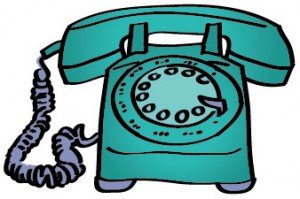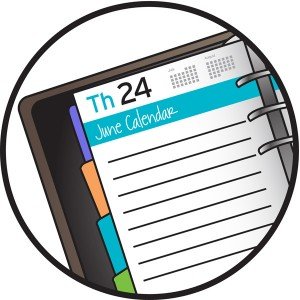Did you know your productivity decreases 20% to 40% when you switch tasks mid-stream? Pretty astonishing, isn’t it? Although it’s hard to believe, it’s true according to a 2001 study conducted by the University of Michigan. The good news is this. You can dramatically increase your productivity simply by staying focused on a single task for longer periods of time.
In your current work life, what is the longest stretch of time you can reliably count on for uninterrupted work? If you’re like most workers, you get interrupted an average of 8 times an hour, or every 7 ½ minutes. Yet it takes 20 to 30 minutes to transition into deep, critical and creative thought. If you end your typical work day frustrated by what you’ve been able to accomplish, hopefully this new information will help you create a plan for increased productivity. Schedule uninterrupted work sessions into your work day and respect them like an appointment with your most important client. Here’s how.
Step 1: Identify Your Interrupters
Interruptions come in two forms. Those brought on by others. And those we bring on ourselves. For the next day or two, make a “distractions list” by jotting down each interruption you encounter. Start with the ideas below and add to them until you come up with a comprehensive list of your daily efficiency robbers.
 Telephones / email (land-line, cell phone, Blackberry)
Telephones / email (land-line, cell phone, Blackberry)- Beepers / pagers
- People / drop-in visitors
- Your own thoughts
- Visual distractions and physical clutter
If you work in a home office, be extra diligent in your search for interrupters. In addition to the list above, you’re likely to be distracted by incomplete housework, a buzzing dryer demanding your immediate attention, or fuzzy boundaries between your work life and personal life, both in terms of time and physical space.
Step 2: Create a Workable Schedule
 Your workable schedule carves out time for handling everything on your “distractions list” and creates blocks of uninterrupted, focused work time. First, schedule your uninterrupted blocks of time during your most productive hours of the day. Then, fill in your schedule with times to handle each of the items on your “distractions list.” During your focused time, employ the following strategies to postpone your “interrupters.”
Your workable schedule carves out time for handling everything on your “distractions list” and creates blocks of uninterrupted, focused work time. First, schedule your uninterrupted blocks of time during your most productive hours of the day. Then, fill in your schedule with times to handle each of the items on your “distractions list.” During your focused time, employ the following strategies to postpone your “interrupters.”
- Telephones + email: Turn off your email. Forward your land-line to voice mail. Turn off your cell phone. Ask an assistant to take your calls.
- Beepers / pagers: To reduce unnecessary interruptions, establish parameters for when people may beep or page you (like in case of emergency only) and be very selective about whom you give these numbers to.
- People / drop-in visitors: If you work in an office environment, shut your door during your focused work session. If your workspace is a cubicle, position yourself away from the door and invest in a set of headphones. When your headphones are on, they will send a “do not disturb” message to those around you.
- Your own thoughts / mental distractions: Before starting your focused work session, give yourself ten minutes to empty your brain clutter. Take out a piece of paper and write down everything on your mind … things you need to do, calls to make, ideas, and so on. When your brain is empty, start working on your project. Keep your “distractions pad” handy to capture any other thoughts that pop-up while you’re working.
- Visual distractions and physical clutter: Organize your office to eliminate piles, stacks and other clutter. Keep out and in sight only those items you use daily or inspire you. Get in the habit of putting away your papers and work materials before switching tasks or wrapping up for the day. Remove items from bulletin boards and place them in a binder system instead.
- Home office challenges: Define boundaries, both in terms of your physical workspace and your time utilization. Have certain places and times for business and other places and times for your personal life. Trying to multi-task by throwing in a load of laundry here and there will result in lowering your productivity – exactly the opposite of your original intent.
Step 3: Set Expectations
If the idea of cutting yourself off from the world for periods of time throughout the day sounds foreign to you, you’re probably aghast at the thought of telling those who rely on you throughout the workday about your grand plan. It’s really just a matter of setting expectations. Here are some ideas:
Let your client’s know the “best times” to reach you. If they choose to drop in or call you outside of those time frames, you’re not obligated to drop everything and sabotage your productivity.
Commit to a service policy such as returning phone calls within 24 hours. Respond to emails at the end of the day, even if it’s just to tell the mailer you’ll put together an answer tomorrow (during your next focused work session.)
Let your coworkers know when you’re available for phone calls, visits, emails and when you’re not. If you give them enough time throughout the day, they should adjust to the change readily. Maybe they’ll even adopt some of your strategies when they see how calm and in control you are!
Remember, it takes 21 days to develop a new habit. This is true not only of you, but of those who have to adjust to your new plan for increased productivity. Work toward the plan above, little by little and step by step. Slowly but surely, you’ll reap the rewards of increased productivity and the peace of mind that comes with it.

“It takes 20 to 30 minutes to transition into deep, critical and creative thought.”
Aby, this perfectly explains what has happened with residential clients who have children who are toddlers or younger, and who have not arranged for a sitter. Consultations can literally double or triple in time.
It isn’t just the time spent getting a little one a snack, or leaving the room to set up a movie, or answer a question. It’s the time to mentally get back to where we were.
I learned to put a note in my email confirmation touching on this after a consultation with a couple that should have taken 4 to 5 hours, took almost two full days. (It was an empty house with nothing for their little boy to do.) And they may not have fully grasped the reason.